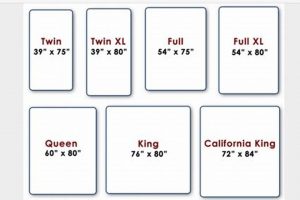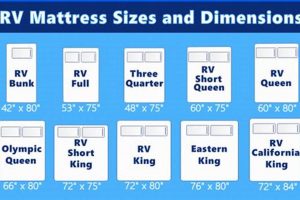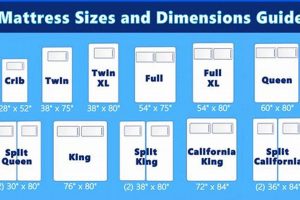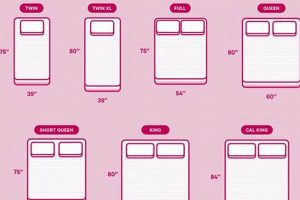Dimensions of bedding designed for younger individuals are a crucial consideration in ensuring proper spinal alignment and restful sleep. These mattresses, often smaller than standard adult sizes, are tailored to accommodate the physical development stages of children and teenagers. For instance, a twin-sized mattress measuring approximately 39 inches wide and 75 inches long is frequently selected for a child transitioning out of a crib or a teenager with limited room space.
Selecting the appropriate dimensions for a younger person’s bed significantly impacts their sleep quality and overall well-being. A properly sized mattress provides adequate support, preventing potential discomfort or developmental issues. Historically, smaller bedding sizes evolved to address the unique needs of growing individuals, emphasizing safety, comfort, and efficient use of space within smaller living areas common in family homes.
Understanding the various dimensions available and the factors influencing the choice is essential. The following sections will delve into specific size options, construction materials, and considerations for optimizing sleep environments for younger individuals, allowing parents and caregivers to make informed decisions.
Guidance on Selecting Bedding Dimensions for Younger Individuals
Optimal selection of bedding dimensions for younger individuals requires careful consideration of several key factors. The following guidance provides insights into ensuring the chosen size meets the specific needs of the child or adolescent.
Tip 1: Consider Age and Development: Infants and toddlers require a crib mattress, which adheres to specific safety standards and dimensions. As children grow, a transition to a larger size, such as a twin, may be appropriate based on their height and physical maturity.
Tip 2: Assess Room Size: Before making a purchase, measure the available space in the bedroom. A larger size, such as a full, might be desirable for comfort but could overcrowd a smaller room. Balance comfort with practicality.
Tip 3: Prioritize Spinal Support: Regardless of the selected dimensions, ensure the mattress offers adequate support for the spine. A firm or medium-firm mattress is often recommended for younger individuals to promote healthy posture during sleep.
Tip 4: Factor in Growth Potential: Children and adolescents experience rapid growth spurts. Select a size that accommodates potential growth for several years to avoid frequent replacements. A twin XL mattress, for example, provides additional length.
Tip 5: Evaluate Material Quality and Safety: Bedding materials should be hypoallergenic and free from harmful chemicals. Look for certifications that indicate adherence to safety standards, such as CertiPUR-US.
Tip 6: Consider Sleeping Habits: If the child is an active sleeper, frequently changing positions during the night, a larger size may provide more freedom of movement and prevent them from rolling off the edge.
Tip 7: Budget Accordingly: Different sizes and materials vary in price. Establish a budget and explore options within that range, focusing on quality and durability to ensure long-term value.
Careful consideration of these factors will contribute to the selection of appropriate bedding dimensions, promoting restful sleep and overall well-being for the younger individual.
The following sections will explore specific mattress types and provide guidance on creating a sleep-conducive environment.
1. Twin dimensions and Youth Mattress Size
Twin dimensions represent a primary subset within the broader category of youth mattress sizes. The selection of a twin-sized mattress is often a direct consequence of addressing the needs of a growing child transitioning from a crib or smaller bed. The dimensions, typically 39 inches wide and 75 inches long, are a key consideration because they must simultaneously accommodate the child’s physical size and the available space within a bedroom. For instance, a parent might opt for twin dimensions when upgrading a child’s sleep arrangement, ensuring the bed provides sufficient length and width while preserving floor space for play or study.
The practical significance of understanding the relationship between twin dimensions and youth mattress size lies in the ability to make informed purchasing decisions. Recognizing that twin dimensions are not universally suitable for all youth, but rather appropriate for a specific age range and body type, allows for tailored selection. Consider a scenario where a pre-teen experiences a significant growth spurt. In this case, although a twin may have initially been adequate, the consideration shifts to a twin XL to address the individual’s increased height, thereby preventing discomfort and ensuring restful sleep. This understanding mitigates the risk of premature mattress replacement and promotes cost-effectiveness.
In summary, twin dimensions are a fundamental component when discussing youth mattress sizes. Their relevance stems from their prevalent use as a transitional sleep solution for children and younger teenagers. Effectively assessing the suitability of twin dimensions within the broader context of youth mattress sizes requires considering factors such as age, height, room size, and budget, ultimately leading to a more targeted and beneficial outcome in ensuring a child’s comfortable and healthy sleep environment.
2. Twin XL length
The extended length of a Twin XL mattress, in relation to standard youth mattress sizes, represents a significant factor when considering the specific needs of adolescents and taller children. Understanding the implications of this increased dimension is crucial for optimizing comfort and support during sleep.
- Accommodating Growth Spurts
Adolescent growth spurts necessitate careful consideration of mattress length. A Twin XL, typically 80 inches long, provides additional legroom that a standard twin (75 inches) does not. This is particularly relevant for teenagers who rapidly outgrow smaller mattresses, preventing discomfort and ensuring proper spinal alignment.
- Dormitory Relevance
Many college dormitories utilize Twin XL mattresses. Introducing this size during adolescence prepares students for the standard bedding encountered in higher education. Early adoption can ease the transition to campus living and minimize disruption to sleep patterns.
- Longevity and Investment
Choosing a Twin XL can extend the lifespan of a youth mattress. The extra length accommodates growth, reducing the likelihood of needing a larger mattress in the near future. This represents a long-term cost-saving measure for parents and caregivers.
- Room Configuration Flexibility
The slender profile of a Twin XL mattress, while longer, still allows for efficient space utilization in smaller bedrooms. This is beneficial in shared rooms or apartments where optimizing floor space is paramount, balancing comfort with practicality.
The extended length of the Twin XL mattress offers tangible benefits within the realm of youth bedding, addressing growth considerations, preparing individuals for future living arrangements, and promoting cost-effectiveness. Careful evaluation of these factors ensures that the chosen mattress adequately supports the evolving needs of the child or adolescent.
3. Full size width
The consideration of full size width is a critical aspect of selecting a youth mattress. Its dimensions offer a transition point between the space constraints of smaller sizes and the expansive nature of adult bedding. Examining its role is essential in making informed decisions.
- Accommodation of Restless Sleepers
The increased width of a full-size mattress (approximately 54 inches) allows restless sleepers more freedom of movement during the night. This prevents the discomfort of constantly reaching the edge of the bed, promoting more restful sleep. For active children, the additional space is often beneficial.
- Suitable for Older Teenagers
Full-size mattresses are often a practical choice for older teenagers approaching adulthood. Their larger frames require a wider sleeping surface, and a full-size mattress provides sufficient space to avoid feeling cramped. This can be particularly pertinent for taller individuals or those who prefer to sleep in various positions.
- Potential for Shared Sleeping
While not ideal for regular co-sleeping, a full-size mattress offers the option for occasional shared sleeping with a parent or sibling in situations such as illness or anxiety. The extra width provides a degree of comfort and space that a smaller mattress cannot offer.
- Impact on Room Space
The wider footprint of a full-size mattress impacts the overall layout of a bedroom. Careful measurement of the available space is necessary to ensure the mattress fits comfortably without overcrowding the room. This is especially important in smaller bedrooms where maximizing floor space is crucial.
The full-size width, therefore, offers a notable increase in sleeping surface for youths. However, the decision to choose a full-size should be balanced with considerations of room dimensions and the sleeper’s specific needs and preferences. The transition to this larger size necessitates a thoughtful approach to ensure it provides the intended benefits without compromising the functionality of the bedroom.
4. Thickness options
The selection of appropriate thickness represents a crucial aspect when considering youth mattress size. Mattress thickness significantly impacts support, comfort, and the overall ergonomic suitability of the sleeping surface for developing individuals.
- Impact on Support and Spinal Alignment
Thickness directly influences the ability of a mattress to provide adequate support for a child’s spine. Thicker mattresses generally offer a more substantial core, improving weight distribution and minimizing pressure points. Inadequate thickness can lead to spinal misalignment and discomfort, particularly for side sleepers or children with developing musculoskeletal systems.
- Material Composition and Durability
The total thickness of a mattress is determined by the cumulative depth of its constituent layers (e.g., comfort layers, support core). Thicker mattresses often incorporate a greater volume of higher-density materials, enhancing their durability and resistance to sagging over time. A thinner mattress may compress more readily, reducing its lifespan and negating any initial cost savings.
- Consideration of Bed Frame and Safety
The chosen thickness must align with the bed frame’s design and safety standards. A mattress that is too thick can compromise the effectiveness of side rails on bunk beds or loft beds, increasing the risk of falls. Conversely, a mattress that is too thin may not adequately fill the frame, creating gaps that pose safety hazards.
- Ergonomic Suitability and Accessibility
Thickness impacts the overall height of the bed, affecting ease of access for younger children. A mattress that is excessively thick may make it difficult for a small child to climb into bed independently, while a mattress that is too thin may result in an uncomfortably low sleeping surface. Proper thickness ensures ergonomic suitability and promotes a safe and accessible sleep environment.
In conclusion, thickness is an integral attribute of youth mattresses, influencing support, durability, safety, and accessibility. Careful assessment of thickness relative to the child’s age, size, bed frame, and specific needs is essential for optimizing sleep quality and ensuring a safe and comfortable sleep environment.
5. Support system
The support system within a youth mattress is paramount, directly influencing spinal alignment, pressure distribution, and overall sleep quality. The dimensions of the mattress, determined by its size designation, dictate the physical parameters within which this support system must function. Therefore, understanding the connection between the support system and youth mattress size is essential for optimizing sleep health in growing individuals.
- Innerspring Coil Configuration
The arrangement of innerspring coils within a mattress’s core provides foundational support. Coil gauge, density, and interconnection methods vary, affecting firmness and responsiveness. A youth mattress incorporating a closely packed coil system within a full-size dimension, for example, would offer more uniform support than a similar system in a twin, where coil distribution may be less dense due to reduced surface area. The resulting effect on spinal alignment directly impacts sleep quality.
- Foam Density and Composition
Foam-based support systems, commonly utilizing polyurethane or memory foam, rely on density and composition to deliver targeted support. A high-density foam core in a twin XL mattress can effectively contour to the body and minimize pressure points, promoting restful sleep. Conversely, a low-density foam in a full-size mattress might compress excessively, leading to sagging and compromised support, especially for heavier individuals. The relationship between foam properties and mattress dimensions determines the degree of support offered.
- Zoned Support Implementation
Zoned support systems incorporate varying levels of firmness across different mattress regions to accommodate specific body areas. A zoned system within a twin mattress typically focuses on providing enhanced lumbar support, considering the smaller sleep surface. Implementing a similar zoning strategy in a full-size mattress requires careful recalibration to account for the increased width, ensuring appropriate support for the shoulders, hips, and legs. Effective zonal support is contingent upon the spatial relationship defined by the mattress’s size.
- Edge Support Reinforcement
Edge support, often achieved through reinforced coils or foam encasements, prevents mattress sagging along the perimeter. Robust edge support is particularly relevant for children who tend to sleep near the edge of the bed or utilize the edge for sitting. The effectiveness of edge support in a twin mattress directly impacts the usable sleeping surface, while adequate edge support in a full-size mattress enhances its longevity and prevents premature deformation. Therefore, the degree of edge reinforcement must align with the mattress’s dimensions.
The interaction between the support system’s characteristics and youth mattress size directly affects its suitability for a given individual. The coil density, foam composition, zonal support strategy, and edge reinforcement must be calibrated to complement the mattress dimensions. Choosing a support system without considering the spatial constraints and opportunities presented by the mattress size leads to compromised comfort and support, potentially undermining spinal health and sleep quality.
6. Material composition
Material composition is intrinsically linked to the performance and suitability of a youth mattress relative to its size. The choice of materials directly affects factors such as support, comfort, breathability, and durability, all of which are crucial considerations in ensuring a safe and healthy sleep environment for younger individuals. For instance, a smaller twin-sized mattress constructed with high-density memory foam will provide a markedly different sleeping experience compared to the same size mattress utilizing a low-density polyurethane foam core. The former offers enhanced pressure relief and spinal alignment, while the latter may lack adequate support, particularly for children with developing musculoskeletal systems.
The dimensions of a youth mattress directly influence the quantity and arrangement of materials used in its construction. Larger mattresses, such as full-size or twin XL models, require a greater volume of materials to maintain uniform support across the entire sleeping surface. This can impact the overall cost of the mattress and necessitate careful consideration of material density to prevent excessive weight or sagging. Moreover, the type of materials employed must be hypoallergenic and free from harmful chemicals to mitigate potential health risks for children and adolescents. For example, mattresses incorporating natural latex or certified organic cotton are often preferred due to their reduced allergenicity and VOC emissions.
In summary, material composition constitutes a critical element in the overall design and performance of a youth mattress, directly interacting with the defined dimensions to determine its suitability for a specific age group and body type. The selection of materials must prioritize support, comfort, durability, and safety, reflecting an understanding of the unique needs of developing individuals. Challenges in material selection include balancing cost considerations with the desire for high-quality, non-toxic materials and ensuring that the chosen materials effectively complement the mattress size to deliver optimal sleep health.
7. Room compatibility
The relationship between youth mattress size and room compatibility is fundamental to ensuring a functional and aesthetically pleasing living space. The dimensions of a bedroom often dictate the maximum permissible size of the mattress, creating a constraint within which bedding choices must be made. Selecting an inappropriately large mattress can impede movement, restrict access to furniture, and negatively impact the overall ambiance of the room. Conversely, a mattress that is too small may appear disproportionate, failing to adequately utilize available space and potentially compromising the sleeper’s comfort.
An illustrative scenario involves a small bedroom designed for a young child. In such a space, a twin-sized mattress is frequently the optimal choice, providing adequate sleeping space while leaving sufficient room for essential furniture and play activities. Introducing a full-sized mattress into this scenario could result in overcrowding, making it difficult for the child to navigate the room and hindering their ability to engage in other activities. Conversely, in a larger bedroom designated for an older teenager, a full-sized or even a twin XL mattress might be more appropriate, providing ample sleeping space without overwhelming the overall layout. In both instances, the dimensions of the room directly influence the selection of the mattress size, demonstrating the practical significance of considering room compatibility. Failure to accurately assess room dimensions prior to purchase can lead to dissatisfaction and the potential need for costly returns or exchanges.
In conclusion, room compatibility serves as a primary determinant in the selection of youth mattress size. While comfort and support are essential considerations, the physical constraints of the bedroom often dictate the range of viable options. Careful measurement and planning are crucial to ensure that the chosen mattress size optimizes both functionality and aesthetics, creating a comfortable and inviting sleep environment. Challenges can arise in unusually shaped rooms or spaces with limited square footage, requiring creative solutions such as custom-sized mattresses or strategically placed furniture to maximize room utilization.
Frequently Asked Questions
The following section addresses common inquiries concerning the selection of appropriate bedding dimensions for younger individuals, providing clarity and guidance on this critical decision.
Question 1: What constitutes a “youth mattress size”?
The term encompasses a range of mattress dimensions designed specifically for children and adolescents. Common sizes include twin, twin XL, and full, each tailored to accommodate different age groups and room dimensions. Crib mattresses, while used by youths, typically are excluded from this categorization due to differing safety regulations.
Question 2: At what age should a child transition from a crib mattress to a larger size?
The transition typically occurs when a child reaches approximately 35 inches in height or demonstrates the ability to climb out of the crib. This generally corresponds to the ages of 18 months to 3 years, but individual development varies.
Question 3: Does mattress thickness significantly affect support for younger individuals?
Yes, mattress thickness plays a critical role in providing adequate support and spinal alignment. Thicker mattresses generally offer a more substantial support core, improving weight distribution and minimizing pressure points. Insufficient thickness can lead to discomfort and potential developmental issues.
Question 4: Is material composition an important factor when selecting a youth mattress?
Absolutely. Materials should be hypoallergenic and free from harmful chemicals to minimize the risk of allergies and respiratory issues. Certifications such as CertiPUR-US indicate compliance with safety standards regarding foam composition and emissions.
Question 5: How does room size influence the choice of youth mattress size?
Room dimensions are a primary determinant in selecting an appropriate mattress size. A larger mattress may overcrowd a small room, hindering movement and functionality. Careful measurement of the available space is essential prior to purchase.
Question 6: Are there specific safety considerations when selecting a youth mattress?
Yes. Bedding should meet safety standards regarding flammability and chemical emissions. Additionally, ensure that the mattress thickness is compatible with bed frame designs, particularly for bunk beds or loft beds, to prevent falls or other hazards.
Careful consideration of these factors will contribute to an informed decision regarding the selection of appropriate bedding dimensions, promoting restful sleep and overall well-being for the younger individual.
The following section will explore mattress types appropriate for youth and provide guidance on creating a sleep-conducive environment.
Youth Mattress Size
This exploration has outlined the salient factors governing the selection of appropriate bedding dimensions for younger individuals. The discussion encompassed the nuanced considerations of size, material composition, support systems, and room compatibility, emphasizing the importance of tailoring mattress selection to meet the unique needs of developing bodies. Careful deliberation of these elements is essential to optimize sleep quality and promote healthy physical development.
The information provided underscores the need for a proactive and informed approach to youth bedding choices. By prioritizing evidence-based considerations and adhering to safety standards, caregivers can ensure that the sleep environment contributes positively to the overall well-being and developmental trajectory of younger individuals. The informed application of these principles remains paramount in fostering healthy sleep habits from an early age.




![Best Queen Size Mattress with Boxspring [Deals!] Organic & Natural Mattress Buyer’s Guide: Non-Toxic Sleep Solutions Best Queen Size Mattress with Boxspring [Deals!] | Organic & Natural Mattress Buyer’s Guide: Non-Toxic Sleep Solutions](https://mattressworldpa.com/wp-content/uploads/2025/07/th-2253-300x200.jpg)
![Futon vs Reg Mattress Size: Are They The Same? [Guide] Organic & Natural Mattress Buyer’s Guide: Non-Toxic Sleep Solutions Futon vs Reg Mattress Size: Are They The Same? [Guide] | Organic & Natural Mattress Buyer’s Guide: Non-Toxic Sleep Solutions](https://mattressworldpa.com/wp-content/uploads/2025/07/th-2252-300x200.jpg)

